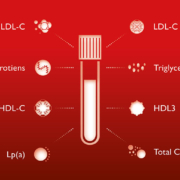Total solution for lipid and cardiac risk testing
Cardiovascular disease caused by atherosclerosis is the leading cause of morbidity in Western Countries [1]. It involves the hardening and narrowing of vessels in the systemic system. The process originates from the build-up of fatty deposits through a process known as atherogenesis. If the build-up increases, plaque rupturing may occur leading to myocardial infarction [2].
The mission of The National Lipid Association (NLA) is “to enhance the practice of lipid management in clinical medicine.” NLA advocates advancing the current lipid testing profile as the traditional panel consists of testing LDL cholesterol (LDL-C), HDL cholesterol (HDL-C) and triglycerides, which only detects approximately 20 % of all atherosclerotic cardiovascular disease patients. Advanced lipid testing is recommended to optimize patient treatment [3].
Offering a total solution for lipid and cardiac risk testing, Randox has developed novel and superior performance markers to identify the true weight of lipid profiling. Its range of niche and superior performance assays comprises 13 assays including: small dense LDL-C (sdLDL-C), Lipoprotein (a) (Lp(a)) and HDL3-C.
sdLDL-C will more readily permeate the inner arterial wall having a lower affinity to the hepatic LDL-C receptor which circulates in the blood longer and more susceptible to oxidation.
As sdLDL-C is particularly atherogenic, a person with elevated sdLDL-C levels has a 3-fold increased risk of myocardial infarction [4].
Elevated Lp(a) levels are associated robustly and specifically with increased cardiovascular disease (CVD) risk. The unique Randox Lp(a) assay is one of the only methodologies on the market that detect the non-variable part of the Lp(a) molecule which suffers minimal size related bias.
HDL3-C is the scavenger of cholesterol within arterial walls and if HDL3-C levels are significantly depleted, the ability to remove this cholesterol is reduced. Therefore, it is widely accepted that there is an inverse correlation between HDL3-C and CVD risk.
It is necessary to review the traditional lipid testing panel, enabling clinicians to gain a more comprehensive view of a patient’s CVD risk and therefore take the appropriate
measures to prevent CVD related deaths.
References
1. Burnett JR. Lipids, lipoproteins, atherosclerosis and cardiovascular disease. Clin Biochem Rev 2004; 25(1): 2 [cited: 3 December 2018]. https://www.ncbi.nlm.nih.gov/pmc/articles/PMC1853363/.
2. Zimmermaann KA. Circulatory system: facts, function & diseases. Live Science [Online] 16 March 2018 [cited: 3 December 2018]. https://www.livescience.com/22486-circulatory-system.html.
3. National Lipid Association. National Lipid Association releases updated recommendations on the use of PCSK9 inhibitors at the 15th Annual Scientific Session. [Online] no date [cited: 3 December 2018]. https://www.lipid.org/nla/national-lipid-association-releases-updated-recommendations-use-pcsk9-inhibitors-15th-annual.
4. Austin MA, Breslow JL, Hennekens CH, Buring JE, Willett WC, Krauss RM. LDL subclass patterns and risk of MI. JAMA 1988; 260(13): 1917–1921.
Supplier: [No title]
Website:



